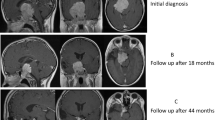Abstract
The differential diagnosis of tumors at the base of the skull comprises meningiomas, neurinomas, gliomas, metastatic carcinomas, chordomas, epidermoids, and pituitary adenomas. About half of the pituitary adenomas are prolactinomas which are unique in a sense that medical therapy causes rapid tumor shrinkage and symptomatic improvement. We report on two patients in which the diagnosis of an invasive macroprolactinoma was masked by apparently low prolactin levels caused by a high-dose hook effect in the chemiluminometric assay. The first case a 49 year old male with impairment of hearing on the left side was presented in the Department of Otorhinolaryngology. A massive invasively growing tumor was demonstrated on a cranial MRI. Endocrine tests revealed normal pituitary function and normoprolactinemia. The patient underwent debulking surgery, occipitocervical fusion because of destruction of the first cervical vertebra and subsequent irradiation. The histopathological diagnosis was invasive prolactinoma. A repeat prolactin (PRL) sample, which was assayed using serial dilutions, revealed a real PRL level of 89,700 ng/ml. Dopamine agonist therapy was initiated under which PRL levels declined in parallel with tumor size. The second case a 40 year old male was presented with acute visual loss. Cranial MRI showed a large tumor at the base of the skull. Based on a transnasal biopsy, the preliminary diagnosis was a poorly differentiated carcinoma for which emergency irradiation was performed. Endocrine tests demonstrated partial hypopituitarism and moderate hyperprolactinemia. Hydrocortisone was substituted and dopamine agonist therapy was started because of moderate hyperprolactinemia. The final histopathological diagnosis was invasive prolactinoma. A repeat PRL sample assayed in serial dilution demonstrated an apparent rise in PRL with a maximum value of 6,460 ng/ml. Under dopamine agonist therapy, PRL declined to normal values, tumor size decreased and cranial nerve palsies disappeared. The apparently falsely low prolactin levels in the initial work-up of both patients were caused by a high-dose hook effect in the PRL assay. Serial dilutions of serum PRL samples is, therefore, mandatory in the diagnostic work-up of patients with large invasive tumors at the base of the skull. This avoids unnecessary aggressive and dangerous treatment like surgery or radiotherapy in cases where pharmacological treatment may be the choice.
Similar content being viewed by others
References
Jefferson G. The invasive adenomas of the anterior pituitary (The Sherington Lectures). Liverpool: Liverpool University Press, 1955;3.
Pernicone PJ, Scheithauer BW, Sebo TJ et al. Pituitary carcinoma. Cancer 1997;79:804–812.
Cunnah D, Besser M. Management of prolactinomas. Clin Endocrinol 1991;34:231–235.
Wilson C. Extensive personal experience. Surgical management of pituitary tumors. J Clin Endocrinol Metab 1997;82:2381–2386.
Bevan JS, Webster J, Burke CW. Dopamine agonists and pituitary tumor shrinkage. Endocr Rev 1992;13:221–235.
Luizzi A, Dallabonzana D, Oppizzi G et al. Low dose of dopamine agonists in the long-term treatment of macroprolactinomas. N Eng J Med 1985;313:656–659.
Verhelst J, Abs R, Maiter D et al. Cabergoline in the treatment of hyperprolactinemia: A study in 455 patients. J Clin Endocinol Metab 1999;84:2518–2522.
Ahmed M. Pituitary apoplexy revisited. Arch Intern Med 1993;153:2165–2168.
Arafah BM, Prunty D, Ybarra J et al. The dominant role of increased intrasellar pressure in the pathogenesis of hypopituitarism, hyperprolactinemia, and headaches in patients with pituitary adenomas. J Clin Endocrinol Metab 2000;85:1789–1793.
Hobbs GA, Watson M, Hess P. A "hook effect" detected in a two-step immunoassay. J Clin Ligand Assay 1995;18:200–204.
Jean E, Blain F, Comtois R. High prolactin levels may be missed by immunoradiometric assay in patients with macroprolactinomas. Clin Endocrinol 1996;44:305–309.
Barkan AL, Chandler WF. Giant pituitary prolactinoma with falsely low serum prolactin: The pitfall of the "high-dose hook effect": Case report. Neurosurgery 1998;42:913–915.
Author information
Authors and Affiliations
Rights and permissions
About this article
Cite this article
Schöfl, C., Schöfl-Siegert, B., Karstens, J.H. et al. Falsely Low Serum Prolactin in Two Cases of Invasive Macroprolactinoma. Pituitary 5, 261–265 (2002). https://doi.org/10.1023/A:1025334001748
Issue Date:
DOI: https://doi.org/10.1023/A:1025334001748




